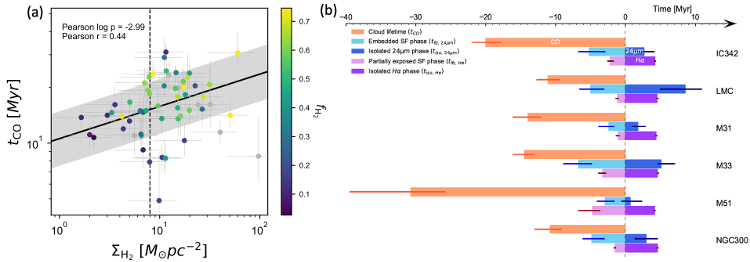| EPoS Contribution |
|
Systematic determination of evolutionary time-scales from molecular cloud assembly to embedded stars and HII regions
Jaeyeon Kim ARI/ZAH, Heidelberg, DE | |
| The processes of star formation and feedback take place on the scales of giant molecular clouds (GMCs; ~100 pc) within galaxies and play a major role in governing galaxy evolution. However, the detailed characteristics of these processes are unknown due to a lack of systematic observational constraints, and it is still a key open question which physical mechanisms regulate the evolutionary cycle between gas and stars in galaxies. By applying a recent statistical method to high-resolution multi-wavelength observations, we can now measure the duration of each of the successive phases of this cycle, from GMC assembly to the dispersal of the molecular gas, as well as the embedded and exposed phases of young stellar regions. We find that clouds live for about 1-3 GMC crossing times (5-30 Myr). CO and Halpha emission are found coincident for 1-5Myr, during which time stellar feedback efficiently disperses the surrounding molecular gas. These timescales show galaxy-to-galaxy variations, correlating with the galactic environment across an unprecedented sample of 60 galaxies from the PHANGS survey (e.g. molecular gas surface density, stellar mass). These correlations reveal the role of galactic-scale dynamical processes on the small-scale evolutionary cycle of molecular clouds, star-formation, and feedback. Furthermore, in the 6 nearest galaxies of our sample, we have established that young stellar regions remain heavily obscured for 1-4 Myr after the onset of star formation (10-25 % of the cloud lifetime) and bright in 24um emission, before becoming also visible in Halpha. This provides direct constraints on the processes at play during the earliest phases of star formation. With our accepted JWST Large Program, we will extend this analysis to 19 more galaxies, and determine the role of the large-scale galactic environment in setting the duration of the embedded phase of star formation. | |
 | |
| Caption: The left panel shows the correlation between the measured cloud lifetime and the large-scale molecular gas surface density for 60 galaxies. Each point is colored by the molecular gas fraction. The right panel shows, for a subset of six galaxies, refined evolutionary timelines by including 24um observations. These describe the evolution from molecular clouds to the embedded star-forming phase and then finally to exposed young stellar regions. The time during which CO is visible is indicated in orange, the time during which 24um and Halpha are visible without CO are shown respectively in dark blue and dark purple. The timescales for the feedback phase, during which both CO and SFR tracer emissions are observed co-spatially are shown in light blue (for 24um) and light purple (for Halpha). | |
| Collaborators: M. Chevance, Heidelberg U ARI/ZAH, DE D. Kruijssen, Heidelberg U ARI/ZAH, DE A. Leroy, Ohio State U, US A. Schruba, MPE, DE K. Sandstrom, U California, US |
Key publication
Suggested Session: Galactic Dynamics & SF |

